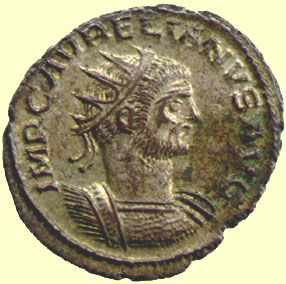 Contents -
Previous Article -
Next Article
Contents -
Previous Article -
Next Article
Throughout Roman history, we find plated coins were often produced. These were sometimes out and out fakes produced by counterfeiters and were sometimes produced officially by the mints. In the days of the Republic and early empire, plated coins were produced by covering copper blanks with a sheet of silver on both sides and heating to weld the metals together. Alternatively, clean heated copper could be dipped into molten silver. Both required a great deal of labor to produce coins so the incentive for profit was not extremely high and this kind of forgery did not become as widespread as it could have if a cheap method of plating had been found. When these ancient plated coins are found, they are still quite collectible if they are truly ancient forgeries. This kind of forgery is called a fourre.
The method of plating that was used in the Third and Fourth Centuries was quite different. The Roman moneyers had discovered that copper is readily etched away by certain acids and corrosive salts that will leave silver untouched. A coin blank was made in the regular way of an alloy containing about 5% silver, sometimes less. The blank was then dipped in a "pickle" solution of corrosive salts and acid. Sometimes the blank was heated and dipped again to speed up the process. The copper was dissolved out, leaving a microscopically thin layer of pure, spongy silver on the surface of the blank. When the blank was struck up with the emperor's portrait and the design on the reverse, the sponge silver was flattened down and spread across the surface of the coin, leaving a beautiful, brilliant silvery finish on the coin. This soon wore off in circulation, though, leaving an ugly gray, brown, white, or black splotchy surface on the coin. A study of the many different patinas that ancient plated coins acquire is an interesting mixture of coin collecting and the chemistry of metals. (contains large JPEG image which may take a long time to download on some systems)
The author guesses that the ancients, probably the Romans themselves discovered this process by accident. It was quite common for coins to have been either lost or hurriedly hidden in a privy during troubled times. If the owner of the coins returned to retrieve them at a later date, it is possible that urine and other chemical byproducts would have had an etching or leaching effect on the surface of coins containing a small amount of silver. The curious Roman may have been prompted to experiment further, discovering this plating principle using somewhat of a "bathtub chenistry" approach. Of course, this is simply speculation on what might have happened. A chemical process like this would have been a closely guarded secret, which master craftsmen would have been reluctant to write down for fear that the secret might be discovered by another. It is unfortunate that so many interesting technological processes learned in antiquity were lost again because of the extreme secretiveness of the guild craftsmen.
Go to next article:
Go back to previous article:
View Some Beautiful Examples of Plated Coins of the Emperor Probus
Plated Coins and the Monetary Reforms of Diocletian